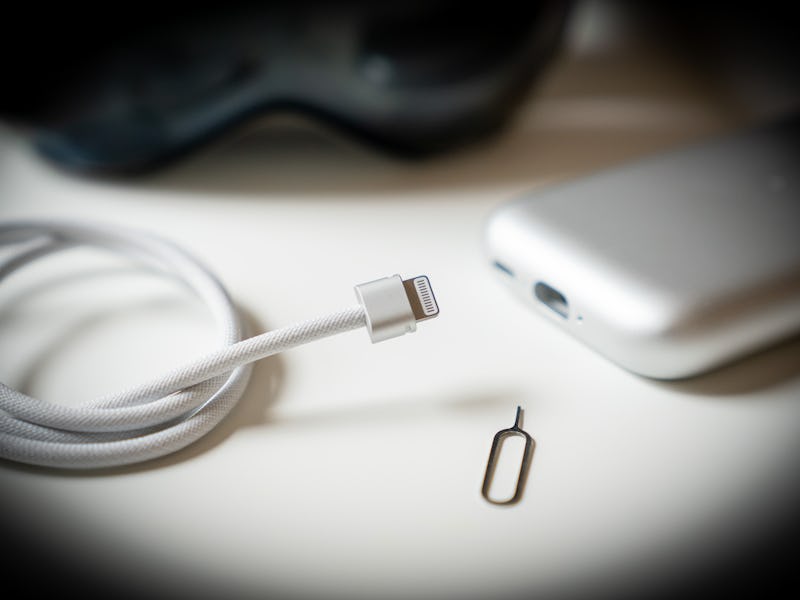What Is the Apple Vision Pro’s Secret Wide Lightning Connector For?
What is the wide Lightning plug called? Why is it back? How mad is the EU?

Well, that was unexpected. Yesterday, when I tweeted a photo of the Apple Vision Pro’s hidden Lightning connector inside of its battery pack, I had no idea it would go viral. I didn’t think for a second that so many people would be interested in a wide Lightning plug. Of all the Apple Vision Pro coverage out there to garner attention. But here we are, so let’s talk about the wide Lightning connector!
First, what happened? I admit my curiosity got the best of me, and after seeing a few commenters ask about the mysterious little hole next to the cable, I couldn’t resist. After carefully weighing my options — you know, risk damaging the battery pack and probably getting in a lot of trouble with Apple — and comparing the hole with the holes on Android phones with SIM card trays, as well as shining a flashlight into it, I dug out a SIM ejector tool and went for it.
Unsurprisingly, with a little force, the cable popped out, and wouldn’t you know it, there was a 12-pin plug with a resemblance to a Lightning plug. Mind you, a regular Lightning connector has 8 pins. This is the first time that we’ve seen any variation on the Lightning plug. Is this a next-gen version of Lightning? Was Apple planning to move its devices to this “fat” or “wide” Lightning plug, but instead was forced by the European Union to switch to USB-C? Inverse reached out to Apple, but didn’t receive an answer by publishing time. We’ll update this story if we get a reply.
What Is This Wide Lightning Plug Called?
That’s what everyone wants to know. Apple hasn’t officially shared the name of the wide Lightning connector in any official documentation. I have some ideas, and I’ve seen some fun ones from my followers. Here are the best ones that I’ve seen from the comments and replies:
- Lightning 2
- Super Lightning
- Lightning Pro
- Lightning Pro Max
- Lightning Max
“Fat Lightning” and “Wide Lightning” are probably the funniest, though.
What Is Wide Lightning For?
Surprise: It’s a wide Lightning port inside of the Apple Vision Pro’s battery pack.
As of now, we only know that it’s used for transferring power from the Vision Pro’s battery pack to the headset. Can it also transfer data, too? Your guess is as good as ours, and we likely won’t know the answer until an Apple genius or teardown specialist inevitably investigates further.
Clearly, because the wide Lightning plug is mechanically locked into the Vision Pro battery by default, it’s not meant for users to access. Instead, it’s mainly for running diagnostics and servicing. Apple has a long history of using proprietary plugs and ports for servicing purposes. For instance, every Apple Watch from Series 0-6 had a “hidden” diagnostic port; Apple ditched it starting in the Series 7.
How Does Wide Lightning Compare to Regular Lightning and USB-C?
As mentioned earlier, wide Lightning has 12 pins instead of 8, which means it’s, well, wider. It’s also a little wider than USB-C. See the comparison shots below.
Could and should Apple have just used USB-C instead of this wide Lightning connector? Yes and yes, but also, come on, this is Apple. The industrial designers working at the Apple Park spaceship love to use proprietary designs that prevent users from modding or breaking their expensive devices.
Is This Why Apple Vision Pro Isn’t Available in Europe Yet?
By now, everyone knows the reason why the iPhone 15 / 15 Pro and new Apple accessories like AirPods Pro 2 have USB-C ports: the European Union made Apple switch to the “universal” port. And rather than ship USB-C models specifically for Europe, Apple just switched them worldwide. It has been considered a huge win for consumers because now you only need to carry one type of cable to charge most or all of your devices.
Many people are speculating that the use of a wide Lightning plug is perhaps a reason why Apple Vision Pro is not yet available in Europe. A source familiar with the matter has confirmed to Inverse that the EU’s legislation for USB-C on devices had nothing to do with the Vision Pro’s exclusive launch in the U.S. on February 2.
If you go read the EU rules yourself, you’ll find that the new rules only apply to the following categories:
- mobile phones
- tablets and e-readers
- digital cameras and video game consoles
- headphones, earbuds and portable loudspeakers
- wireless mice and keyboards
- portable navigation systems
VR / AR / XR headsets or head-mounted computers are not included in the EU’s new rules. Laptops are, but they have a little longer to comply: “laptops will also be covered by the new rules 40 months following the entry into force of the directive.” It’s possible that the EU will mandate future versions of the Vision Pro or other VR headsets to connect to the battery pack over USB-C. But so far, that’s not the case.
So Many Wide Lightning Memes
When a secret plug goes viral, you meme it, right? Of course, you do. And I’ve seen some good ones.
I might have leaned into it, too...
This article was originally published on